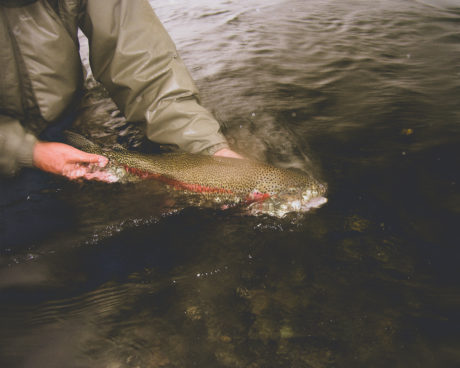
The ability to ‘tail’ a fish, that is, the ability to land fish safely and effectively without a net is a skill every angler should possess. After all, we’ve all been on a trip where the net didn’t make it into the back of the pickup. Regardless, the old adage reigns true; if you want to catch the biggest trout of your life, leave the net and camera at home.
Many steelhead and salmon anglers actually prefer to fish without a net. A net worthy of landing large anadromous species, particularly those that are few and far between, can be a bit cumbersome while wading and some would argue that they’re also worse on the fish.
Regardless of what you fish for, tailing fish is a worthwhile skill and the following tips will help you land more fish, safely release more fish, and protect your gear in the process.
- The Honorable Foot. The old days of ‘beaching’ fish are gone. If keeping fish is your prerogative, then playing fish into inches of water is surely a quick and effective method of landing them. However, if your goal is to release fish, beaching fish is a sure-fire way to increase the chance of mortality upon release. So, if you plan on releasing your fish, please please please land it in at least a foot of water. We call this the Honorable Foot, and it’s a pretty solid rule to fish by.
- Get the Fish Upstream. A common mistake made when tailing fish is grabbing at the leader with the fish directly below the angler. Doing so allows the current to put maximum strain on the leader and fly usually ending in an unexpected head shake causing the fly to slip, the hook to bend out, or the leader the break. Instead, try not to grab the leader until you have coaxed the fish to a position directly in front or upstream of you. This results in less strain on the leader and a better angle between your leader and fly as you make your approach.
- Let it Slip. Whether fishing a single hand or two-handed rod, any 9 to 15 foot rod doesn’t make grabbing the leader particularly easy on a big fish. However, the easiest method for getting a hold of the leader before tailing a fish is as follows. Once you have tired out (not exhausted) your fish and have brought it to within a rod’s length away from you, pinch your line against the cork with your rod hand and use your line hand to strip excess line off the reel. Once you are comfortable with your position of the fish, raise your rod high and slightly behind you while allowing the excess line to slip through the guides. This will cause the line to fall close in front of you, allowing you to grab the fly line. Then simply hand over hand the line as you approach to tail your quarry. Many steelhead anglers utilize the minimal drag of classic click-pawl reels to create a similar effect by allowing the reel to ‘free-spool’ in order to grab the line as well.
- Keep Your Leader Out of the Guides. A simple but common mistake made when performing the tip above is reeling past the leader-fly line connection. Be cautious that the loop to loop or nail knot between your leader and fly line is not in the guides when performing ‘the slip,’ as the subtle catch of the connection in the guides could cause just enough force for a break-off.
- Make the Grab Count. In attempts to be gentle to a prized fish, some anglers attempt to grab the wrist of the caudal softly. We understand that there are good intentions here, but this usually results in a sudden burst of energy, causing the fish to slip free of the grasp and prolong the fight further. Time is the biggest threat to the well being of a fish, so make your grab count in order to send the fish on its way as quickly as possible. Still, having trouble holding on? Consider a landing glove for a quicker, safer, and more effective ‘grip.’
- Lay Your Rod Downstream. Once you have control of the leader and/or the tail of the fish, make sure your rod is pointing downstream. Many many anglers, when caught up in the excitement of a well-fought battle, drop their rod in the most convenient direction the moment they get their hands on their fish. However, laying the rod down pointed upstream often causes the fly line to wrap around the rod tip. Should the fish slip-free with an unexpected burst of energy, this all too often results in a broken rod tip. Make sure your rod tip is pointed downstream and the current will aid in straightening out the fly line while you tend to your fish, greatly reducing the chance of a broken rod.
More on Landing Fish
Leave a Reply